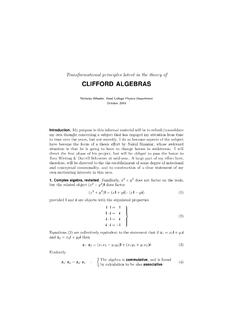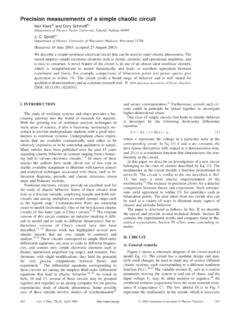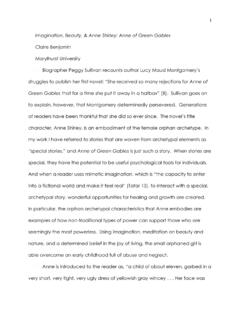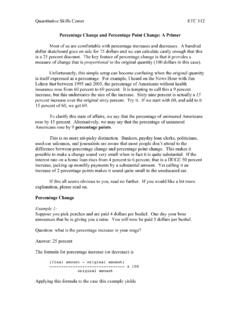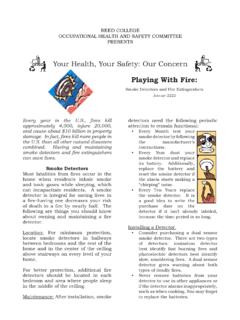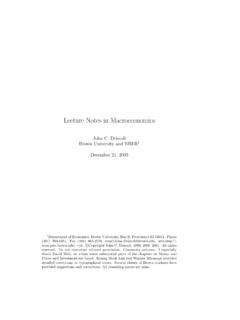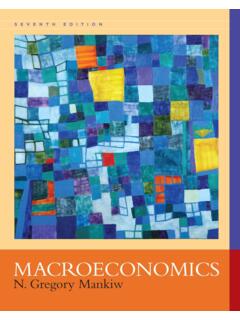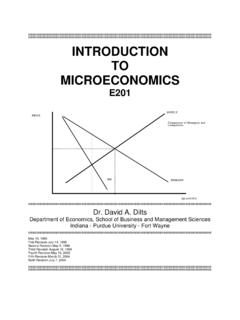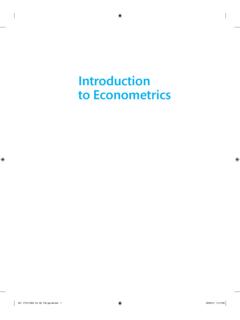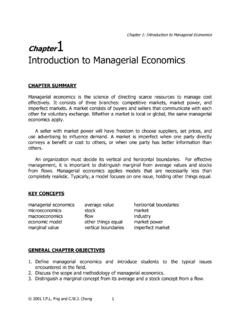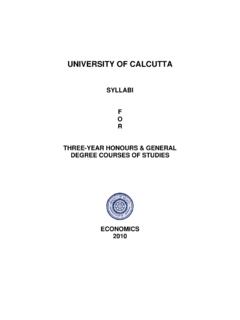Transcription of What is Macroeconomics?
1 What is macroeconomics ? Overview of macroeconomics 4 Macroeconomic Concepts 5 Income and Output 5 Unemployment 5 Factors of Production and Income Distribution 8 Inflation 8 Financial Markets and the Real Economy 10 Openness 11 macroeconomics in the Long Run: Economic Growth 12 macroeconomics in the Short Run: Business Cycles 13 macroeconomics as a Science 15 The Genesis of macroeconomics 15 macroeconomics and Microeconomics 18 Demand and Supply 20 The Methodology of macroeconomics 21 What is to be Explained? 21 Theory and Realism 21 Positive and Normative Analysis 22 Testing Theories: The Role of Data 22 Macroeconomic Modelling and Forecasting 22 Preview of the Book 24 Structure 24 Controversies and Consensus 24 Rigour and Intuition 24 Data and Institutions 24 Europe 25 4 PART I INTRODUCTION TO macroeconomics The Theory of Economics does not furnish a body of settled conclusions immediately applicable to policy.
2 It is a method rather than a doctrine, an apparatus of the mind, a technique of thinking, which helps its possessor to draw correct conclusions. ]. M. Keynes Overview of macroeconomics Unemployment, inflation, booms and busts, finan-cial markets, interest rates, and exchange rates are everyday fare in the news. All these phenomena affect our well-being. This why macroeconomics is so exciting. macroeconomics is more than just head-lines, however: it is a fascinating intellectual adven-ture. The breadth of issues it covers is evidence enough of its inherent complexity. Yet, a few sim-ple ideas can go a long way seeing through com-plex situations. macroeconomics is also enormously useful. People, rich or poor, are affected as jobs appear or vanish and as prices change. Businesses can gain or lose large amounts of money when their environment changes, regardless of how well they are managed.
3 Citizens want to understand what their governments are up to. Dramatic events like depressions, when overall economic activity is very far below average and unemployment soars, or hyperinflations, when prices are increasing at monthly rates of 50% or more, can tear at a soci-ety's social fabric, and yet can be prevented when policy-makers apply sound economic principles. But are 'sound economic principles' valid? The events that started in 2007 and led to the Great Recession and the Eurozone crises have led some observers to conclude that macroeconomics needs to be overhauled. Yet it is also common to blame medical doctors for epidemics, and or messengers for bringing bad news, and that doesn't sound fair. Macroeconomists are in a similar situation today. We will argue that macroeconomics as a field has proved its mettle.
4 To be sure, our understanding is very far from perfect. In particular, macroecono-mists are not good at making forecasts and the pro-fession has failed to see the crisis coming. Yet, the principles underlying our field made it possible to understand these dramatic events surprisingly well as they unfolded. They also contained prescriptions for what needed to be done. When governments heeded this advice, the economic situation in fact improved. In any case, we did not experience the Great Depression of the 1930s, and we know why. Besides helping diagnose such situations, the mate-rial in this book will teach you humility: Some events, both economic and political, cannot be pre-dicted. This includes banking and financial crises, which contain strong behavioural elements. A key feature of macroeconomics is that it is geared to finding solutions.
5 Its principles may look abstract at first, but they readily lead to policy pre-scriptions. These prescriptions are directly related to the observation of economic events with unde-sirable consequences, which in turn presumes agreement on what is to be measured and how measurements are made. Before the arrival of macro-economics, concepts such the gross domestic product (GDP), the consumer price index, or the unemployment rate simply did not exist. Some of these concepts are presented in Section , many more will be introduced as we move through the book. The next step is to formulate a diagnosis. A key challenge at this stage is to distinguished between business cycles, or short-run fluctuations of output and employment, and long-run trends. This distinction, which is presented in Sections and , shapes the structure of the book; both repre-sent the subject of macroeconomics and the objec-tive of macroeconomic policies.
6 Equipped with these preliminary essentials, we can then examine in what sense macroeconomics is a science (Section ) and how it helps us to reason about the world around us (Section ). The chapter con-cludes with a preview of the book's contents (Section ). In -:be mm nomic v. income' gross don cus ed !!e DW cheir ma 2015 am German) trill Obi ay size. capita,\~ che samt hould b time bee 1 more this issu constant 1 for this 1 course ol A quid cries are' e, bu1 uctuatic cycles.'-" andcydt rant obsE annual g in Arger e lattei -e peric rae com 1 A crillio1 zeros {le ? A usefuJ peranm ; its possessor rescriptions wernments tion in fact erience the know why. ;, the mate-ility: Some mot be pre-icial crises, ~nts. ; that it is s may look policy pre-:tly related with unde-presumes I and how tl ofmacro-domestic lex, or the t.}
7 Some of , many Lrough the iagnosis. A tinguished ruations of rends. This ns and oth repre-the objec->ped with 1 examine a science about the tpter con-contents CHAPTER 1 WHAT IS macroeconomics ? 5 Macroeconomic Concepts Income and Output The most important indicator of a nation's eco-nomic well-being is a measure of its output and income during a given year, which is called the gross domestic product (GDP). The concept will be dis-cussed in greater detail in Chapter 2. GDPs are very large numbers, and it is good to develop a feel for their magnitudes. In 2015, the GDP of the UK in 2015 amounted to about trillion pounds; in Germany, trillion euros; in the Netherlands trillion euros; in Denmark trillion Obviously, these numbers are related to coun-try size, which is why we often look at GDP per capita, which range from 25,000 to 40,000 euros in the same year across the countries of Europe.
8 We should be careful when comparing these data over time because GDPs can change for two reasons: (1) more is produced, and (2) prices of those goods change. We will learn in Chapter 2 how to deal with this issue using so-called real GDP numbers-at constant prices, so to speak. Table , which corrects for this using prices in the year 2000, displays the course of GDP over the past century. A quick look at the table reveals that (1) most coun-tries are characterized by steady growth of GDP over time, but that (2) there are significant and recurring fluctuations of GDP around its trend, called business cycles. We return to the distinction between trends and cycles in separate sections later. Another impor-tant observation is that small differences in average annual growth rates cumulate over time to huge dif-ferences in levels.
9 A striking example: GDP per capita in Argentina was about 15% larger than that of Sweden in 1900; 110 years later, it had fallen to half the latter's value. The reason? While both grew over the period, Sweden's economy expanded at a rate compared with Argentina's Sinlilarly, it is 1 A trillion (1 000 000 000 000) (US usage) is 1 followed by 12 ze ros (1012). 2 A u se ful rule of thumb is that a country growing at rate g% per annum needs about 70/g years to double in size. striking to note how much poorer the Asian coun-tries were in comparison to Western Europe and the US in 1900. Some of them caught up Oapan), or started to catch up recently (China after the late 1970s) while others still have not (Bangladesh). A natural concern is whether GDP, or GDP per capita, is a good indicator of individual well-being.
10 GDP says nothing about the distribution of income in the economy, which may also matter to its resi-dents. Many researchers are now examining issues related to happiness and quality of life, not just economic output. One of the robust findings on research in this area is that while GDP is not every-thing, it is certainly one important determinant of economic and social well-being. Some evidence is provided in Figure , which displays on the verti-cal axis the results of coordinated public opinion polls. People were asked how satisfied they were with their lives. The horizontal axis corresponds to that year's GDP per capita in each country. The fig-ures show that deep unhappiness is only found in poor countries. Yet, people in some countries seem to be poor and happy ( Bhutan) while the French and the Germans seem less happy than the Danes and the Finns, who have similar standards of living.


